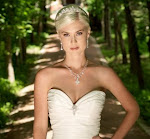 The same dress style can look and feel quite different in a different color or fabric. In the search for your wedding gown, you'll want to try on several different dresses so you can find the perfect fabric and the most flattering color to match your complexion. Here are four tips to consider when shopping for the gown of your dreams with particular emphasis on fabrics and color.
The same dress style can look and feel quite different in a different color or fabric. In the search for your wedding gown, you'll want to try on several different dresses so you can find the perfect fabric and the most flattering color to match your complexion. Here are four tips to consider when shopping for the gown of your dreams with particular emphasis on fabrics and color.1. Consider the overall feel that you want your gown to create at your wedding.
Your dress will set the tone and theme of the entire wedding more than any other single thing. What do you see when you close your eyes and imagine your wedding day? Are you going to be walking down an aisle, getting married outside or uttering your vows by the soft glow of candlelight? How do you want the fabric to drape across your figure? Do you want the fabric to shine or shimmer? If you're not sure, try on several types of fabrics so you can find out what you like best.
2. Try on several different fabrics and find out what complements your figure and taste.
The fabric of a wedding gown is the basis for its overall look and feel and will influence cost more than any other single thing. Here are some of the more common fabrics that you will have to choose from as you search for the "perfect gown:"
- Chiffon is a thin, transparent fabric that can be made out of nylon, poly, silk, or rayon. It drapes very nicely and has a soft, romantic feel to it. It is much lighter than the other fabrics and is a great overlay on satin dresses or skirts.
- Organza is a sheer fabric that is crisper and heavier than chiffon. It shines and shimmers in the light and can make the dress "light up" in your bridal portraits. Organza is primarily used for layering and overlays on skirts.
- Satin is a smooth weave fabric that has a sheen or lustrous gloss on one side. It is typically made from acetate, poly, silk, or other manmade fibers. The majority of wedding gowns today are made from some kind of satin. More expensive gowns will be constructed from Italian matte satin, duchesse satin, or silk satin.
- Tulle is a machine made crisp, netting-like material that is used for veils, ball gown skirts, and underskirts. It is what makes dresses 'pouf' out. Most brides either love tulle or they hate it. You'll have to try it on for yourself to find out how you feel about it.
3. Consider your complexion when selecting the color of your gown.
Even though whtie has traditionally been the color of most gowns, more and more gowns are being designed with color in the details. Many off white, ivory or rum pink/champagne colored dresses may be the perfect way to complement your complexion. Fairer skin tones look better in ivory or creamier tones since they often have a softer look against your skin in comparison with the stark contrast you may find with whiter fabrics. Many bridal stores will have the same dress style in either white or ivory and may have the dress with colors that are hand painted or woven into the fabric so you can get a sense for what you like best. Although having color in your gown may seem pretty fashion forward, consider that the colors on your gown can tie in corresponding colors for your reception or bridesmaid dresses.
4. Don't get so caught up in all the details that you forget how you feel and look in the dress.
There are so many fabrics to choose from. Don't let yourself get overwhelmed and confused. Just remember to choose a color and fabric that best reflects the mood you are trying to create at your wedding. Knowing the types of textured materials that are available can help you look for and create a special look for your dress. You will want to try on a variety of gowns to help you find what you like best as you bring "the perfect gown" into closer focus. As you decide on your gown, trust your own instincts. Ask yourself these three questions of the final dresses you are seriously considering: 1) Which dress do I feel the prettiest in?; 2) which dress accentuates my best feature?; and 3) Which dress most fits my personality or style? Try on each gown and go through this process until you have eliminated all of the dresses to the final one. Once you've found a gown that is everything you've imagined, smile and relax--you've done it!
Heather Butler is the owner of Arizona's Bridal & Formal--Arizona's #1 Factory Outlet for Bridal & Formal Wear, located at 2450 W. Broadway Rd., Suite 120 in Mesa, Arizona. She can be reached at 480-517-0027 or via email at info@arizonabridal.com



No comments:
Post a Comment